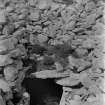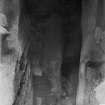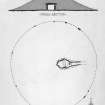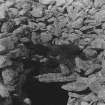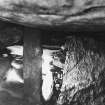Scheduled Maintenance
Please be advised that this website will undergo scheduled maintenance on the following dates: •
Tuesday 3rd December 11:00-15:00
During these times, some services may be temporarily unavailable. We apologise for any inconvenience this may cause.
Field Visit
Date 4 September 1914 - 24 July 1924
Event ID 1103471
Category Recording
Type Field Visit
Permalink http://canmore.org.uk/event/1103471
Chambered Cairn, Barpa Langass, Ben Langass.
About 400 yards south of the road some 7 miles west-south-west of Lochmaddy, on the north-western slope of Ben Langass, at an elevation of about 130 feet above sea level, is a chambered cairn knows as Barpa Langass. The monument is in a very good state of preservation; the main structure of stones, devoid of soil or vegetation, seems intact except for several cavities on the surface of the mound, from which the stones have been displaced, and for some damage at the exterior end of the entrance passage, from which the lintels have been removed. Previous to the erection of the structure the site had been levelled by excavation on the higher or south-eastern side, the excavated hollow extending some 5 ½ feet beyond the mound and measuring 2 ½ feet in height on the counterscarp. The cairn is circular and measures 80 feet in diameter and 14 feet in height, the outline being marked at irregular intervals by small slabs set on end, chiefly on the northern arc. These boundary slabs have an average height of about 2 feet and are placed from 9 ½ feet to 30 feet apart, although two towards the south-east are only separated by a distance of 4 ¼ feet. (Fig. 131 [SC 1106515])
In the east side of the cairn the entrance passage to a perfect megalithic chamber is exposed, the outer part of the passage for a distance of about 19 feet having the lintels removed and being blocked up with fallen stone. The passage, the walls of which are chiefly formed of slabs set on edge, continues in a straight course for a further 6 feet where the chamber is entered at its south-east corner. The outer section of the passage has been low-roofed and some 2 feet 9 inches in width. Its height is not ascertainable. As already stated the lintels have been removed, but where the first of the remaining lintels, a stone 5 feet long by 4 feet 5 inches broad by 9 ½ inches thick, is seen in position, the passage measures 2 feet 10 inches wide. From this point to the inner doorway of the chamber the south wall is formed mainly of one large slab 5 ¾ feet in length, while the opposite side is built of smaller stones. At the doorway of the chamber the roof of the passage rises to a height of 5 ¾ feet and its width contracts to 2 feet2 inches at the top and 1 foot 7 inches at the bottom. A pillar, 1 foot wide by 6 inches thick by 1 foot 5 inches at the ingoing, forms the northern jamb. The southern wall of the chamber is not continued in the line of the south wall of the passage but stands 20 inches farther north. The chamber measures 9 ¼ feet from east to west and 6 feet from north to south and its height varies from about 6 feet at the entrance to over 7 feet at the opposite northwest corner. The walls of the chamber consist of five slabs of large size, one on the south side measuring 4 feet 7 inches in length and 5 feet in height, the opposite slab 5 feet by 6 ¼ feet, the two in the west end 3 feet 8 inches and 3 feet 4 inches in width respectively, and one in the east end 21 feet. Two of the slabs do not reach the roof, but the vacancies between the slabs themselves and between the short ones and the roof are carefully built up with smaller stones. Two very large slabs placed across from north to south form the roof, with a third superimposed to cover a gap of 1 foot 4 inches between the first two. (Figs. 129, 130 [SC 1106514, SC 1106512])
The chamber and passage occupy only a small portion of the cairn, and it is quite likely that, as reported, there is another chamber in the northern part of the mound.
Several fragments of thin pottery with ornamentation apparently belonging to three different vessels. wood ashes, burnt bones, a calcined flint barbed arrowhead, a scraper and five other flakes of flint as well as a thin disc of talc 1 foot 4 inches in diameter, pierced with two holes close together near the edge, were found among debris removed from the chamber and are now preserved in the National Museum.
RCAHMS 1928, visited 4 September 1914 and 24 July 1924.
OS map: North Uist xl.














